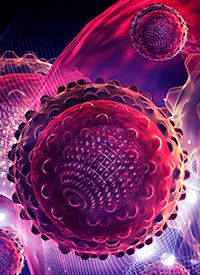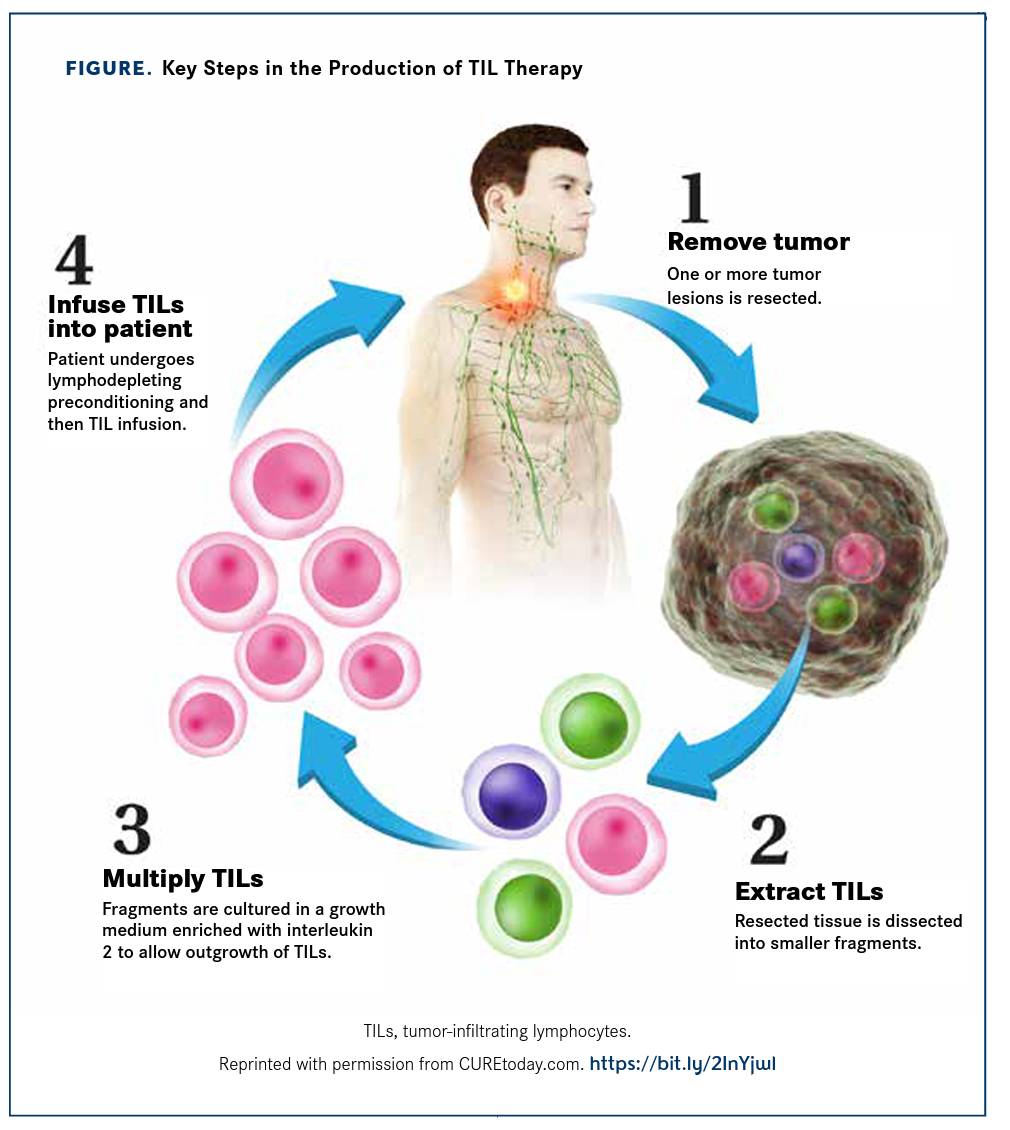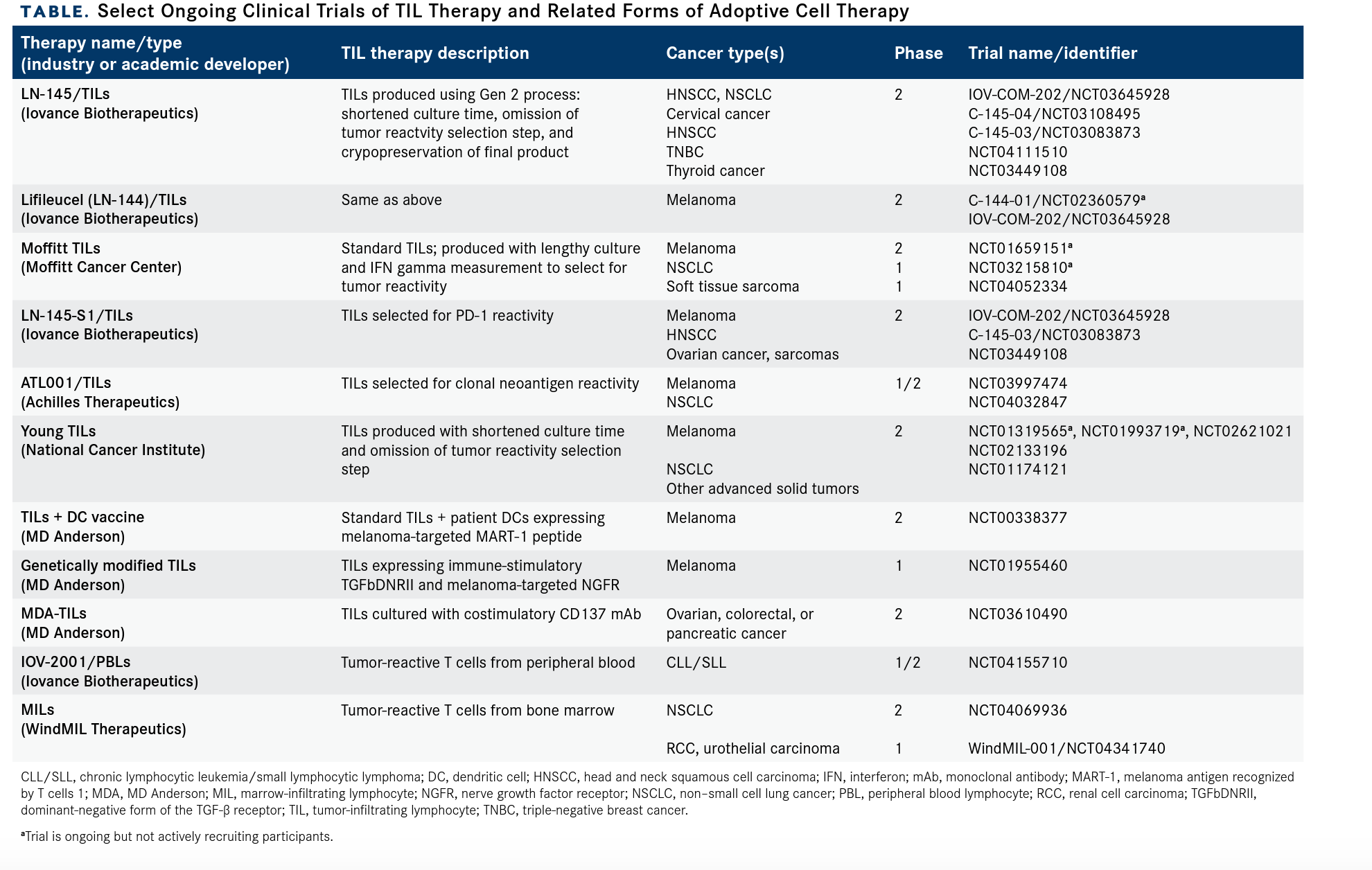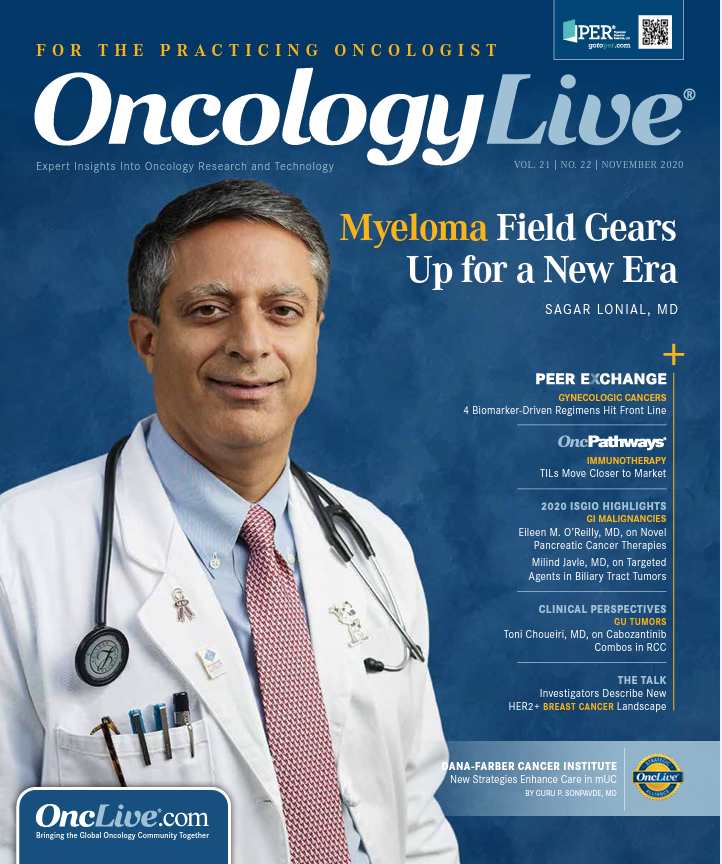Publication
Article
TILs, the Ultimate in Personalized Immunotherapy, Move Closer to Market
Author(s):
November 24, 2020 - Until now, the field of cell-based immunotherapy has been dominated by chimeric antigen receptor (CAR) T cells, with groundbreaking FDA approvals for 3 drugs across several types of hematologic malignancies. In solid tumors, however, CAR T-cell therapies have yet to gain ground.

November 24, 2020 - Until now, the field of cell-based immunotherapy has been dominated by chimeric antigen receptor (CAR) T cells, with groundbreaking FDA approvals for 3 drugs across several types of hematologic malignancies. In solid tumors, however, CAR T-cell therapies have yet to gain ground.1,2
Headline-making data have shined a light on a closely related form of cell-based immunotherapy: tumor-infiltrating lymphocytes (TILs).3-5 Despite having demonstrated promising activity in patients with metastatic melanoma, TIL products have had limited marketability due to a time-consuming and costly manufacturing process.6-8
Yet, the enduring appeal of TILs lies in the fact that they already are trained to recognize a patient’s specific tumor antigens and, unlike CAR T cells, do not need to be genetically engineered.6-8 The persistence of academic institutions and pharmaceutical companies over the past 4 decades in pursuing these therapies may be about to pay off.
Capitalizing on a streamlined manufacturing process, Iovance Biotherapeutics has developed several new TIL products.9 Lifileucel (LN-144) has produced substantial clinical responses in patients with metastatic melanoma previously treated with systemic therapy, including an immune checkpoint inhibitor (ICI).3,10
Meanwhile, data from clinical trials with another Iovance TIL product, LN-145, and a TIL therapy developed at Moffitt Cancer Center in Tampa, Florida, provide examples of the mounting evidence of the activity of TIL therapy in other types of solid tumors.4,5
With Iovance reporting plans to file for regulatory approval for lifileucel in meta-static melanoma and for LN-145 in cervical cancer in the near future,10,11 the first FDA-approved TIL-based therapies may finally reach the clinic.
Exploiting T Cells
TIL therapies, a form of adoptive cell transfer, capitalize on the underlying genomic instability of cancer cells, which causes the accumulation of genetic mutations that give rise to antigens for which expression is limited to tumors (neoantigens). Upon recognition of these neoantigens, cytotoxic T lymphocytes (CTLs) become activated, provoking an antitumor immune response. Tumor-specific CTLs have been found in the blood and tumor tissue of patients with cancer. The latter, referred to as TILs, can engage in tumor cell killing upon recognition of their cognate ligand.12,13
There is significant heterogeneity across cancer types with regard to the density of TILs, with tumors broadly categorized as immunologically “hot” or “cold” based in part on this metric.14,15 Although a high degree of lymphocytic infiltration is associated with good prognosis in several cancer types, tumors have evolved numerous mechanisms to suppress the immune response.12
The goal of immunotherapy is to amplify or reestablish a patient’s antitumor immune response. Because of their central role in tumor cell killing, T cells have been the focus of immunotherapeutic design, leading to groundbreaking developments in the form of small-molecule ICIs and cell-based immunotherapies.
The most renowned example of the latter group is CAR T-cell therapy: T cells collected from the peripheral blood are genetically modified to recognize a tumor antigen and direct their cytotoxic activity against the cancer cells expressing it. Despite substantial success culminating in FDA approvals across several types of hematologic malignancies, CAR T cells face a number of challenges.1,2
An alternative to CAR T-cell therapy is TILs, which are harvested from the tumor. As a polyclonal pool that has already encountered the patient’s cancer cells, TILs are enriched for T cells endowed with natural reactivity against a variety of tumor antigens. Because TILs come directly from a patient’s own tumor, they represent the ultimate form of personalized therapy.6-8
TIL Therapy
TIL therapy was pioneered at the National Cancer Institute (NCI) beginning in the late 1980s, notably by Steven A. Rosenberg, MD, PhD, a 2013 Giants of Cancer Care® award winner.16 In a series of seminal studies, lymphocytes were extracted from tumor tissue that had been resected from patients with metastatic melanoma. After being rapidly expanded outside the body and then reinfused into the same patient, these lymphocytes could induce tumor regression.17-19
Across these and other studies conducted at academic institutions around the world, TIL therapy has consistently achieved objective response rates (ORRs) of 40% to 50% in patients with melanoma, including complete responses (CRs) in 10% to 20% of patients. These CRs were often durable, lasting 3 to 5 years.8
Despite these impressive results, TIL therapy has not been commercialized, largely because of the significant cost and complexity of the manufacturing process and the overshadowing of TILs by the development of ICIs for metastatic melanoma treatment.6-8
The TIL manufacturing process begins with the resection of 1 or more tumor lesions, dissection of the resected tissue into multiple smaller fragments, and culture of those fragments in a growth medium enriched with interleukin 2 (IL-2), which facilitates outgrowth of the TILs from the tumor tissue (FIGURE).6-8
In the original protocol, several TIL cultures are established per patient and tested for recognition of the patient’s tumor cells using an assay that measures the production of effector cytokines, such as interferon gamma. Reactive cells are pooled and then undergo a rapid expansion phase, in which they are cultured with IL-2, an anti-CD3 antibody, and irradiated peripheral blood mononuclear “feeder” cells, all of which support the activation and propagation of the TILs. The total time from tumor resection to final TIL product is between 5 and 7 weeks with this protocol.6-8
Before TILs can be reinfused, patients undergo a lymphodepleting conditioning regimen to optimize the environment into which the TILs are introduced, predominantly by depleting immunosuppressive cells. This is achieved through chemotherapy with cyclophosphamide and fludarabine and/or total body irradiation.6-8
Because they recognize antigens specific to the individual patient’s tumor, TILs cause off-target toxicity more rarely than CAR T cells. The most common toxicities are related to the lymphodepleting regimen; thus, efforts to further optimize it are ongoing.6-8
FIGURE. Key Steps in the Production of TIL Therapy

Advancing TIL Therapy
The prospect of truly personalized therapy with durable efficacy and limited toxicity has lent an enduring appeal to TIL therapy and several types of approaches are under study (TABLE). Continued efforts to advance its clinical development have mainly focused on reducing production time.
Investigators at the NCI developed a “young TIL” process, which shortens the production process by eliminating the original protocol’s cytokine measurement step to select tumor-reactive TILs.6,20
Among the most successful efforts to streamline TIL production is Iovance Biotherapeutic’s Gen 2 process, which takes just 22 days. Iovance has reported that TIL manufacture has been successful for over 90% of more than 300 patients. The company has also developed a Gen 3 process, further decreasing the manufacturing time to 16 days. Both processes are being used in ongoing clinical development of Iovance’s TIL products lifileucel and LN-145.7,9
The C-144-01 trial (NCT02360579) is a multicohort phase 2 clinical trial of lifileucel in patients with metastatic melanoma who have received at least 1 prior systemic therapy, including an ICI.
Long-term data from cohort 2, presented at the 2020 American Society of Clinical Oncology (ASCO) Virtual Scientific Program, demonstrated an ORR of 36.4% and 2 CRs among 66 patients at a median follow-up of 18.7 months.3
All patients experienced at least 1 treatment-emergent adverse event (TEAE), most commonly thrombocytopenia, chills, anemia, pyrexia, neutropenia, and febrile neutropenia, and 97% experienced grade 3/4 TEAEs, predominantly thrombocytopenia, anemia, and febrile neutropenia.
An additional 75 patients were enrolled in cohort 4 of this study, designed to serve as the pivotal cohort in support of a biologics license application that Iovance hopes to file soon. Initial results revealed an ORR of 32.4%, including 1 CR, in 68 evaluable patients after a median follow-up of 5.3 months.10
TABLE. Select Ongoing Clinical Trials of TIL Therapy and Related Forms of Adoptive Cell Therapy

Beyond Melanoma
TIL research and development has focused on melanoma, but investigators have recently had success growing TILs from multiple other tumor types. There have been case reports of durable remissions in patients with meta-static colorectal cancer, cholangiocarcinoma, and breast cancer.6,21
Several reports have demonstrated the feasibility of isolating TILs from metastatic non–small cell lung cancer (NSCLC), in addition to showing encouraging preliminary signs of clinical activity.21 In recently presented results of a phase 1 clinical trial (NCT03215810), patients with metastatic NSCLC who had progressed on nivolumab (Opdivo) received a TIL product manufactured at Moffitt Cancer Center.
Patients received nivolumab 240 mg every 2 weeks for 4 cycles. Those who showed signs of progression were then treated with TILs, followed by nivolumab 480 mg every 4 weeks for up to a year. At the time of the presentation, 20 patients had been enrolled, of whom 13 had progressed on nivolumab and received TILs and 2 were scheduled to receive TILs. Two patients had achieved durable CRs, which were ongoing at almost 1 year.
An additional 3 patients achieved clinical remission, which they maintained with local ablative therapy performed between 6 months and 17 months post TIL infusion, after isolated new lesions emerged. The majority of AEs resolved quickly, with common nonhematologic AEs including hypoalbuminemia, hypophosphatemia, nausea, hyponatremia, and diarrhea.4,22
Meanwhile, LN-145 is being evaluated in the ongoing phase 2 C-145-04 trial (NCT03108495) in patients with metastatic or persistent cervical cancer. Preliminary results were presented at the 2019 ASCO Annual Meeting.
Among 27 patients, the ORR was 44.4%, with 3 CRs. Median duration of response was not reached at a median follow-up of 7.4 months. The most common TEAEs were chills, anemia, diarrhea, pyrexia, and thrombocytopenia. Overall, 96.3% of patients experienced grade 3/4 TEAEs, most commonly anemia and thrombocytopenia.5
On the basis of these data, LN-145 was awarded breakthrough therapy and fast track designations by the FDA, and Iovance plans to use the C-145-04 trial results to support an application for approval in patients with cervical cancer.11,23,24
Challenges Remain
Despite significant promise, challenges to broad clinical implementation of TIL therapy remain. Many tumor types are not very immunogenic, with TILs limited in number or subject to immunosuppressive factors in the tumor microenvironment that restrict their cytotoxic activity.13,25
Investigators are exploring ways to further enhance the survival, expansion, and cytotoxic activity of TILs through, for example, addition of costimulatory antibodies to the culture medium (NCT02652455, NCT03610490).8,26,27 They are also evaluating new means of selecting the tumor-reactive populations of cells from among TILs.8
Iovance is developing LN-145-S1, a TIL product expanded from the subset of PD-1expressing cells in the tumor infiltrate, which may select for tumor-reactive CD8+ T cells.9,28 Similarly, a human papillomavirus (HPV)selected TIL product was recently developed, which produced an ORR of 28% among 18 patients with HPV-associated cervical cancer (NCT01585428). Two patients had ongoing CRs, which lasted more than 4 years.29
Achilles Therapeutics is developing ATL001, a TIL product that is selectively enriched for T cells targeting clonal neoantigens, which arise from the earliest stages of cancer development and should be present in all cancer cells.21
The company’s manufacturing process involves analyzing blood and tumor samples via whole-exome and -transcriptome sequencing to identify candidate clonal neoantigens. Dendritic cells (DCs) isolated from the patient’s blood are then loaded with peptides corresponding to these antigens and are cultured with TILs to activate and expand T cells that recognize the specific antigens expressed by the DCs. Phase 1/2 clinical trials of ATL001 are under way.21
In efforts to overcome the immunosuppressive tumor microenvironment, TILs have been genetically modified to express a dominant-negative form of the TGF-β receptor, which helps the TILs resist the T-cell–inhibitory effects of TGF-β. This TIL product is currently being evaluated in clinical trials (NCT01955460, NCT02650986). Additionally, investigators have transduced TILs with genes encoding chemokine receptors to promote homing of the cells to the tumor site.30,31
Finally, investigators are examining the possibility of extracting tumor-reactive T cells from bone marrow, dubbed marrow- infiltrating lymphocytes (MILs), to treat hematologic malignancies. These cells have exhibited highly tumor-specific properties when activated and expanded in samples from patients with multiple myeloma.32
WindMIL Therapeutics is developing both unmodified MILs and gene-modified CAR-MILs. The company initiated a phase 2 study (NCT04069936) of MILs in patients with metastatic NSCLC in late 2019, the design of which was highlighted at ASCO 2020.33,34 WindMIL Therapeutics also recently presented preclinical data demonstrating superior antitumor efficacy of CAR-MILs compared with conventional CAR T-cell therapy in cultured cells and a mouse model of multiple myeloma.35
References
- Cerrano M, Ruella M, Perales MA, et al. The advent of CAR T-cell therapy for lymphoproliferative neoplasms: integrating research into clinical practice. Front Immunol. 2020;11:888. doi:10.3389/fimmu.2020.00888
- FDA approves first cell-based gene therapy for adult patients with relapsed or refractory MCL. News release. FDA. July 24, 2020. Accessed October 6, 2020. https://www.fda.gov/news-events/press-announcements/fda-approves-first-cell-based-gene-therapy-adult-patients-relapsed-or-refractory-mcl
- Sarnaik A, Khushalani NI, Chesney JA, et al. Long-term follow up of lifileucel (LN-144) cryopreserved autologous tumor infiltrating lymphocyte therapy in patients with advanced melanoma progressed on multiple prior therapies. J Clin Oncol. 2020;38(suppl 15):10006. doi:10.1200/JCO.2020.38.15_suppl.10006
- Creelan B, Wang C, Teer J, et al. Durable complete responses to adoptive cell transfer using tumor infiltrating lymphocytes (TIL) in non-small cell lung cancer (NSCLC): a phase I trial. Cancer Res. 2020;80(suppl 16):CT056. doi:10.1158/1538-7445.AM2020-CT056
- Jazaeri AA, Zsiros E, Amaria RN, et al. Safety and efficacy of adoptive cell transfer using autologous tumor infiltrating lymphocytes (LN-145) for treatment of recurrent, metastatic, or persistent cervical carcinoma. J Clin Oncol. 2019;37(suppl 15):2538. doi:10.1200/JCO.2019.37.15_suppl.2538
- Rohaan MW, van den Berg JH, Kvistborg P, Haanen JBAG. Adoptive transfer of tumor-infiltrating lymphocytes in melanoma: a viable treatment option. J Immunother Cancer. 2018;6(1):102. doi:10.1186/s40425-018-0391-1
- Fardis M, DiTrapani K, Finckenstein FG, Chartier C. Current and future directions for tumor infiltrating lymphocyte therapy for the treatment of solid tumors. Cell Gene Ther Insight. 2020;6(6):855-863. doi:10.18609/cgti.2020.088
- Hopewell EL, Cox C, Pilon-Thomas S, Kelley LL. Tumor-infiltrating lymphocytes: streamlining a complex manufacturing process. Cytotherapy. 2019;21(3):307-314. doi:10.1016/j.jcyt.2018.11.004
- Investigating the power of tumor infiltrating lymphocytes for treatment of cancer. Iovance Biotherapeutics. October 2020. Accessed October 6, 2020. https://ir.iovance.com/static-files/14662ea1-537d-4967-a558-94ae63ec1154
- Iovance reports pivotal cohort 4 data for tumor infiltrating lymphocyte (TIL) therapy lifileucel from C-144-01 clinical study in advanced melanoma. News release. Iovance Biotherapeutics, Inc. May 27, 2020. Accessed November 8, 2020. https://ir.iovance.com/news-releases/news-release-details/iovance-reports-pivotal-cohort-4-data-tumor-infiltrating
- Iovance Biotherapeutics provides cervical cancer program updates following end of phase 2 meeting with U.S. Food and Drug Administration (FDA). News release. Iovance Biotherapeutics. July 2, 2019. Accessed October 6, 2020. https://ir.iovance.com/news-releases/news-release-details/iovance-biotherapeutics-provides-cervical-cancer-program-updates/
- Antohe M, Nedelcu RI, Nichita L, et al. Tumor infiltrating lymphocytes: the regulator of melanoma evolution. Oncol Lett. 2019;17(5):4155-4161. doi:10.3892/ol.2019.9940
- Durgeau A, Virk Y, Corgnac S, Mami-Chouaib F. Recent advances in targeting CD8 T-cell immunity for more effective cancer immunotherapy. Front Immunol. 2018;9:14. doi:10.3389/fimmu.2018.00014
- Lanitis E, Dangaj D, Irving M, Coukos G. Mechanisms regulating T-cell infiltration and activity in solid tumors. Ann Oncol. 2017;28(suppl 12):xii18-xii32. doi:10.1093/annonc/mdx238
- Shembrey C, Huntington ND, Hollande F. Impact of tumor and immunological heterogeneity on the anti-Cancer immune response. Cancers (Basel). 2019;11(9):1217. doi:10.3390/cancers11091217
- Rosenberg SA, Packard BS, Aebersold PM, et al. Use of tumor-infiltrating lymphocytes and interleukin-2 in the immunotherapy of patients with metastatic melanoma. N Engl J Med. 1988;319(25):1676-1680. doi:10.1056/NEJM198812223192527
- Rosenberg SA, Yannelli JR, Yang JC, et al. Treatment of patients with metastatic melanoma with autologous tumor-infiltrating lymphocytes and interleukin 2. J Natl Cancer Inst. 1994;86(15):1159-1166. doi:10.1093/jnci/86.15.1159
- Rosenberg SA, Yang JC, Sherry RM, et al. Durable complete responses in heavily pretreated patients with metastatic melanoma using T-cell transfer immunotherapy. Clin Cancer Res. 2011;17(13):4550-4557. doi:10.1158/1078-0432.CCR-11-0116
- Dudley ME, Wunderlich JR, Robbins PF, et al. Cancer regression and autoimmunity in patients after clonal repopulation with antitumor lymphocytes. Science. 2002;298(5594):850-854. doi:10.1126/science.1076514
- Geukes Foppen MH, Donia M, Svane IM, Haanen JBAG. Tumor-infiltrating lymphocytes for the treatment of metastatic cancer. Mol Oncol. 2015;9(10):1918-1935. doi:10.1016/j.molonc.2015.10.018
- 21. Robertson J, Salm M, Dangl M. Adoptive cell therapy with tumour-infiltrating lymphocytes: the emerging importance of clonal neoantigen targets for next-generation products in non-small cell lung cancer. Immuno-Oncol Technol. 2019;3:1-7. doi:10.1016/j.iotech.2019.09.003
- Nivolumab and tumor infiltrating lymphocytes (TIL) in advanced non-small cell lung cancer. Clinicaltrials.gov. Updated October 30, 2020. Accessed November 8, 2020. https://clinicaltrials.gov/ct2/show/NCT03215810
- Iovance Biotherapeutics announces breakthrough therapy designation for LN-145 for treatment of advanced cervical cancer patients who have progressed on or after chemotherapy. Iovance Biotherapeutics. May 22, 2019. Accessed October 6, 2020. https://ir.iovance.com/news-releases/news-release-details/iovance-biotherapeutics-announces-breakthrough-therapy/
- Iovance Biotherapeutics was granted fast track designation for LN-145 for cervical cancer. Iovance Biotherapeutics. February 26, 2019. Accessed October 6, 2020. https://ir.iovance.com/news-releases/news-release-details/iovance-biotherapeutics-was-granted-fast-track-designation-ln/
- Magalhaes I, Carvalho-Queiroz C, Hartana CA, et al. Facing the future: challenges and opportunities in adoptive T cell therapy in cancer. Expert Opin Biol Ther. 2019;19(8):811-827. doi:10.1080/14712598.2019.1608179
- Amaria RN, Bernatchez C, Forget MA, et al. Adoptive transfer of tumor-infiltrating lymphocytes in patients with sarcomas, ovarian, and pancreatic cancers. J Clin Oncol. 2019;37(suppl 15):TPS2650. doi:10.1200/JCO.2019.37.15_suppl.TPS2650
- Combining PD-1 blockade, CD137 agonism and adoptive cell therapy for metastatic melanoma. ClinicalTrials.gov. Updated September 4, 2020. Accessed October 6, 2020. https://clinicaltrials.gov/ct2/show/NCT02652455
- Salas-Benito D, Casares N, Sarobe P, Lasarte JJ, Hervas-Stubbs S. Pre-selection of PD-1+ tumor-infiltrating CD8+ T cells improves the efficacy of adoptive T-cell therapy. J Immunol Sci. 2018;2(1):55-59. https://www.immunologyresearchjournal.com/articles/preselection-of-pd1--tumorinfiltrating-cd8--t-cells-improves-the-efficacy-of-adoptive-tcell-therapy.html
- Stevanović S, Helman SR, Wunderlich JR, et al. A phase II study of tumor-infiltrating lymphocyte therapy for human papillomavirus–associated epithelial cancers. Clin Cancer Res. 2019;25(5):1486-1493. doi:10.1158/1078-0432.CCR-18-2722
- Forget MA, Tavera RJ, Haymaker C, et al. A novel method to generate and expand clinical-grade, genetically modified, tumor-infiltrating lymphocytes. Front Immunol. 2017;8:908. doi:10.3389/fimmu.2017.00908
- Spear TT, Nagato K, Nishimura MI. Strategies to genetically engineer T cells for cancer immunotherapy. Cancer Immunol Immunother. 2016;65(6):631-649. doi:10.1007/s00262-016-1842-5
- Borrello I, Noonan KA. Marrow-infiltrating lymphocytes – role in biology and cancer therapy. Front Immunol. 2016;7:112. doi:10.3389/fimmu.2016.00112
- Edelman M, Lisberg AE, Koczywas M, et al. Phase IIa study of marrow infiltrating lymphocytes (MILs), an adoptive T cell therapy, alone or in combination with nivolumab in non-small cell lung cancer (NSCLC). J Clin Oncol. 2020;38(suppl 15):TPS9630. doi:10.1200/JCO.2020.38.15_suppl.TPS9630
- WindMIL Therapeutics announces FDA clearance of investigational new drug (IND) application for phase 2 study of marrow infiltrating lymphocytes (MILs) in non-small cell lung cancer. News release. WindMIL Therapeutics. June 25, 2019. Accessed October 6, 2020. http://www.preipopharma.com/press-releases/WindMIL-Therapeutics-Announces-FDA-Clearance-of-Investigational-New-Drug-IND-Application-for-Phase-2-Study-of-Marrow-Infiltrating-Lymphocytes-MILs-in-NonSmall-Cell-Lung-Cancer
- WindMIL Therapeutics to present data demonstrating superior efficacy of CAR-T cells using marrow-infiltrating lymphocytes (CAR-MILs) compared to peripheral blood lymphocytes at the 61st American Society of Hematology Annual Meeting and Exposition. News release. WindMIL Therapeutics. December 9, 2019. Accessed October 6, 2020. http://www.globenewswire.com/news-release/2019/12/09/1957997/0/en/WindMIL-Therapeutics-to-Present-Data-Demonstrating-Superior-Efficacy-of-CAR-T-cells-using-Marrow-Infiltrating-Lymphocytes-CAR-MILs-Compared-to-Peripheral-Blood-Lymphocytes-at-the-6.html










